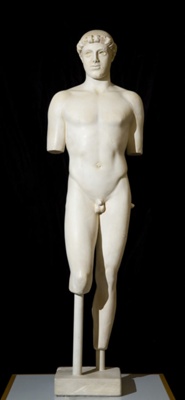< Collection search
< Collection highlights
From:UC Teece Museum of Classical Antiquities
Name/TitlePlaster Cast Copy of The Kritios Boy
About this objectThis is a plaster cast copy of the original artefact found in two parts at the Acropolis in Athens in 1865 and 1888. The sculpture was probably a dedicatory statue, and it is possible that he stood on an Ionic column found in the same vicinity. The column is inscribed with two lines of hexameter verse referring to a dedication to Athena by Kallias, son of Didymaios, the victor in a boy's race at the Panathenaic games. It has also been argued that the Kritios boy represents the hero Theseus. The athletic nude male was a symbol for victory and civic commitment, and was a recurrent image throughout Greek art.
The name "Kritios boy" comes from the 19th-century attribution of the original sculpture to the artist Kritios, best known for his work on the Tyrannicide group of sculptures.
The original Kritios boy is missing his lower arms and right leg. Most replicas of the Kritios boy are displayed as the original now is, mounted onto a base supported by rods. The Logie cast of the Kritios boy suffered damage during the Christchurch earthquakes of 2010, and has since been fully conserved. Repairs are evident on his right thigh and knee.
The Kritios boy is well known for being one of the earliest statues of the Classical period. His contrapposto stance, supporting the weight on one leg with the other slightly bent, is indicative of the aims of Classical sculptors. It is a characteristic pose of the Severe style, as artists transitioned from the sharper angular lines of the Archaic period to a softer, more rounded and volumetric treatment of the body.
The boy’s cap of curls is a feature that is characteristic of sculpture in the Classical period, as it is associated with youth and athleticism, and is often depicted in imagery of Apollo. This cast of the Kritios boy has empty eye sockets, but the original sculpture would have had glass eyes to give the statue a sense of life. This feature was also common to sculpture in the Classical period.
MakerMinistry of Culture Archaeological Receipts Fund
Maker RoleCasting and Copying Workshop
Date Madeca. 1988-1989
PeriodEarly Classical
Place MadeGreece; Athens
Place NotesOriginally manufactured in Attica; From the Athens Acropolis: the torso was found to the southeast of the Parthenon in 1865-1866, while the head was found near the south walls of the Acropolis in 1888.
Medium and MaterialsPlaster
Style and IconographyEarly Classical
Style and IconographyAttic
TechniqueCasting (process)
MeasurementsHeight 1304mm; Width (figure) 358mm; Base 236mm x 234mm
Subject and Association KeywordsFigurative art
Subject and Association KeywordsArt and religion
Named CollectionThe James Logie Memorial Collection, University of Canterbury, New Zealand
Object TypeSculpture
Object numberCC15
Copyright LicenceAll rights reserved
